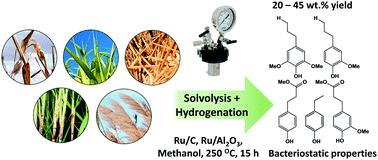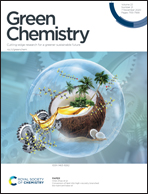Reductive catalytic fractionation of agricultural residue and energy crop lignin and application of lignin oil in antimicrobials†
Abstract
Cheap and abundant waste from bioethanol and agricultural processing industries are an alluring alternative feedstock for biorefineries. In this work, we employ reductive catalytic fractionation (RCF) to depolymerize, over Ru/C powder and Ru/Al2O3 pellets, five herbaceous biomass feedstocks, namely corn stover, miscanthus, switchgrass, sugarcane bagasse, and wheat straw into phenolic monomers with high yields (∼40 wt% based on total (Klason + acid soluble) lignin and >50 wt% when stabilized using aldehydes), leaving behind a carbohydrate pulp residue. Interestingly, a polar solvent is sufficient to solubilize and fragment the lignin polymer into monomers without any catalyst. Contrary to woody biomass, where the monomer yields are positively correlated with the S-content of lignin, principal component analysis indicates that the monomer yields from herbaceous biomass depend on the content of lignin crosslinker – ferulate. Using NMR, we further identify α-6 C–C linked oligomers formed from condensation reactions, explaining the unexpected low monomer yields of high β-O-4 herbaceous biomass. Recyclability experiments indicate that catalyst deactivation occurs through sintering, leaching, and fouling. Lignin oil from herbaceous biomass exhibits bacteriostatic effects against Staphylococcus aureus, highlighting a potential application in functional food development and as a food or feed preservative.



 Please wait while we load your content...
Please wait while we load your content...
